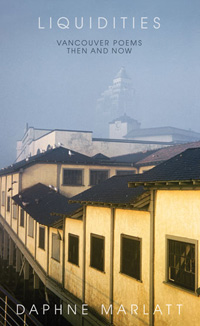Reviews
Poetry Review by Tanis MacDonald
Daphne Marlatt, Liquidities: Vancouver Poems, Then and Now (Vancouver: Talonbooks, 2013). Paperbound. 73 pp. $16.95.
A few weeks ago, I reread Dennis Lee’s Civil Elegies and Other Poems in preparation for teaching it, not only as a book that won the Governor General’s Award for Poetry in 1972 but as a book about the shifting parameters of Canadian civic history. So I was well primed for reading Daphne Marlatt’s Liquidities: Vancouver Poems Then and Now, a book that contains poems previously published as Vancouver Poems by Coach House Press (also in 1972, the year that House of Anansi published Civil Elegies and Other Poems), now reconsidered in light of the changes Vancouver has seen in the last forty years. The new edition by Talonbooks includes some very arresting photographs of the same street corners and other locales, taken between 1905 and 1971, with the implied bonus that Vancouver residents will already have their own internalized images of the appearance of those places in 2013.
While it is in no way necessary to read the original 1972 Vancouver Poems before reading Liquidities, I did, motivated by curiosity about Marlatt’s revisions and encouraged by her beautifully lucid introduction in which she notes that her word for the genius loci of the city, “sh’te,” comes from Noh theatre, a genre she studied for many years and used to excellent effect in her adaptation of a Noh play into The Gull (2008). Asking “What might be the shape of the city’s sh’te or inhabiting presence, its ghostly energy for self-transformation?” Marlatt follows this “unconscious question that drives the whole series of poems, then and now.” The opening poem of the collection shows the sh’te in motion: “the sh’te / comes walking up through humor in the way of / vision, salt. Cedar all over.” This is not nostalgia by any stretch of the imagination, as Marlatt’s skill as a poet and historian has always been to note the simultaneity of memory and the present, or as William Faulkner wrote, “The past is never dead. It’s not even past.” The same poem ends with these lines:
Asphalt
cuts through times, your eye, my tongue, down where a
culvert mouths on the beach the city’s underground:
you come through walking, corpses, bits of metal,
bird cry.
That “coming through walking” is the motion of this book, and using the inhabiting presence as a guide, Marlatt captures the strange shifting urgencies of Vancouver, noting all the while that which has not changed and remains stubbornly and importantly central to the city: its First Nations and Asian citizens, its forests and rivers, its heights and depths, its harbours of industry and their attendant disasters, and the enduring social history of places like the White Lunch cafeteria. The “Vancouver Poems” make up two-thirds of the new collection, thoughtfully revised to emphasize the genius loci, the ghost hand on your elbow as you read. The experience is exhilarating as the poems move through the city according to this insistent but subtle guidance: a powerful drift. The original poems are re-ordered and reimagined, though Marlatt has been respectful of her initial impulses, retaining the freshness of her multilayered view and of her sense of the city as a participant in its own history. Her revisions are deft, bringing into focus what was an ambitious plan in 1972, sometimes regarding Vancouver critically, but never mocking the city’s mercuriality. For instance, “To navigate,” Marlatt’s poem about the Ironworkers/Second Narrows Bridge is about endurance rather than change. She locates the ironworkers who were killed in the 1958 disaster as both perpetually in the air and perpetually in the water, reaching up and falling simultaneously, all of them held in place by the “sky / gap / electrical ab // sense air is / how it parts.” The poem offers a history of the air and water, marked by all the construction and all the disasters and the continuing flow of the river. Marlatt’s syntax and lambent pauses liquefy time and suggest a sinuous citizenship that is both of the city and apart from it.
The collection’s new poems, the “liquidities” of the title, look at the “debt paralysis” of the new Vancouver, and Marlatt’s play on the bitter dregs of “liquid assets about to drain // the real // estate cult” in the face of poverty on Vancouver’s Eastside does not stint on indicting the uneven distribution of wealth. From her Marxist-tinged sci-fi allusion, “what the city drinks eats is people” to her re-use of Digital Natives’ 2011 billboard Tweet, “If you lived under this bridge / you’d be home now,” Marlatt draws the lines connecting the disenfranchised people of the Vancouver Poems to 2013’s Eastside citizenry, asserting that the more things change, the more some things stay exactly, frustratingly, the same. In these poems, the sh’te “comes walking / up through horror in the way of/ vision” through the “freudian body of wifi access.” Liquidities is about the tenacity of locality during an era of massive change in which the shifting sense of civic presence could translate as cultural loss. But Marlatt sees the manifest of the citizen rewritten as a manifest of rigorous provocation, and there is, cheekily, more than a weather report to the final line of the book’s last poem. It is hard not to hear an echo of Galileo’s refusal to recant before the Inquisition in the ending words of Liquidities: “still // it rains,” Marlatt’s invocation of the absolute movement and absolute stillness of coastal civic life.
—Tanis MacDonald









